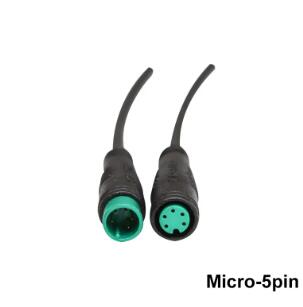How Signal Connectors Handle Power Distribution Alongside Signal Transmission
2024-07-16
Introduction
Signal connectors are integral to various electronic systems, ensuring reliable communication between components. However, many applications also require these connectors to handle power distribution. This dual functionality is critical in fields such as industrial automation, automotive, and telecommunications. This blog explores how signal connectors manage power distribution alongside signal transmission, highlighting the technologies and design considerations involved.
Understanding Signal Connectors
Signal connectors are designed to facilitate the transmission of data or control signals between devices. These connectors come in various forms, such as D-sub, M12, and RJ45, each suited to different applications and environments. The primary function of a signal connector is to maintain signal integrity, ensuring that data is transmitted accurately and without interference.
The Need for Combined Signal and Power Transmission
In many applications, devices require both power and data connectivity through a single interface. This need arises in scenarios where space is limited, cabling complexity must be minimized, or simultaneous power and data transmission is necessary for operational efficiency. Examples include:
- Industrial Automation: Sensors and actuators often need both data signals and power through the same connector to reduce wiring complexity and improve reliability.
- Automotive: Modern vehicles use numerous electronic control units (ECUs) that require integrated power and data connections for systems such as infotainment, safety, and engine management.
- Telecommunications: Network devices such as IP cameras and wireless access points often use Power over Ethernet (PoE) to receive both power and data through a single cable.
Design Considerations for Combined Signal and Power Connectors
1. Pin Configuration and Layout
The design of combined signal and power connectors involves careful planning of pin configuration and layout to ensure efficient transmission and prevent interference:
- Dedicated Power Pins: Specific pins are designated for power transmission, separate from those used for data signals. This separation helps prevent electrical noise from affecting signal integrity.
- Grounding and Shielding: Proper grounding and shielding techniques are used to minimize electromagnetic interference (EMI) between power and signal lines.
2. Current Carrying Capacity
Connectors must be designed to handle the required current for power distribution without overheating or degrading:
- Material Selection: High-quality materials such as copper alloys are used for power pins to ensure low resistance and high conductivity.
- Pin Size and Spacing: Power pins are often larger and spaced further apart than signal pins to accommodate higher current levels and reduce the risk of arcing.
3. Insulation and Dielectric Strength
Adequate insulation is crucial to prevent short circuits and ensure safety:
- Insulating Materials: Connectors use materials with high dielectric strength to provide effective insulation between power and signal paths.
- Creepage and Clearance Distances: Design standards specify minimum distances between conductive parts to prevent electrical breakdown.
4. Heat Dissipation
Power transmission generates heat, which must be managed to maintain connector performance and longevity:
- Thermal Management: Connectors may incorporate features such as heat sinks or use materials with high thermal conductivity to dissipate heat effectively.
- Ventilation: Design considerations include ensuring adequate ventilation around the connector to allow for natural cooling.
Technologies Enabling Combined Signal and Power Transmission
Power over Ethernet (PoE)
PoE technology allows network cables to carry electrical power alongside data signals. This is achieved by using different pairs of wires within the Ethernet cable for power and data transmission. PoE standards such as IEEE 802.3af, 802.3at, and 802.3bt specify power levels and ensure compatibility between devices.
Hybrid Connectors
Hybrid connectors are designed to combine power and signal transmission in a single interface. These connectors are used in applications where reducing cable clutter and improving system reliability are paramount. Examples include:
- M12 Hybrid Connectors: Common in industrial automation, these connectors combine data and power lines within the same robust housing.
- D-sub Hybrid Connectors: Used in various electronic systems, these connectors offer multiple pin configurations to accommodate both power and signal requirements.
USB Power Delivery (USB-PD)
USB-PD is a standard that allows USB connectors to deliver higher levels of power (up to 100W) while maintaining data transmission capabilities. This technology is widely used in consumer electronics, allowing devices to charge quickly and transfer data through the same port.
Practical Applications
Industrial Automation
In industrial automation, connectors that combine power and signal transmission are used to streamline cabling for sensors, actuators, and control systems. This integration reduces installation time and improves system reliability by minimizing potential points of failure.
Automotive Industry
Modern vehicles employ connectors that handle both power and data for various electronic systems, including infotainment, safety, and engine management. These connectors help reduce the weight and complexity of the vehicle’s wiring harness.
Telecommunications
PoE technology is widely used in telecommunications to power devices such as IP cameras, wireless access points, and VoIP phones. This approach simplifies network installations and reduces the need for separate power supplies.
Conclusion
Signal connectors that handle both power distribution and signal transmission are essential in today’s technology-driven world. By integrating power and data capabilities into a single connector, these solutions offer numerous benefits, including reduced wiring complexity, improved reliability, and enhanced operational efficiency. Through careful design considerations and the adoption of advanced technologies like PoE and hybrid connectors, industries can meet their specific connectivity requirements while maintaining the highest standards of performance and safety.



